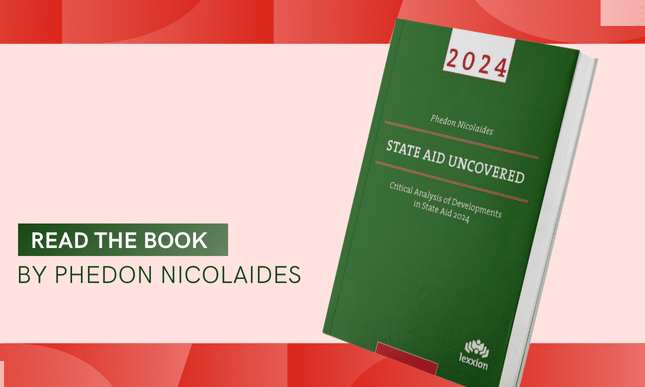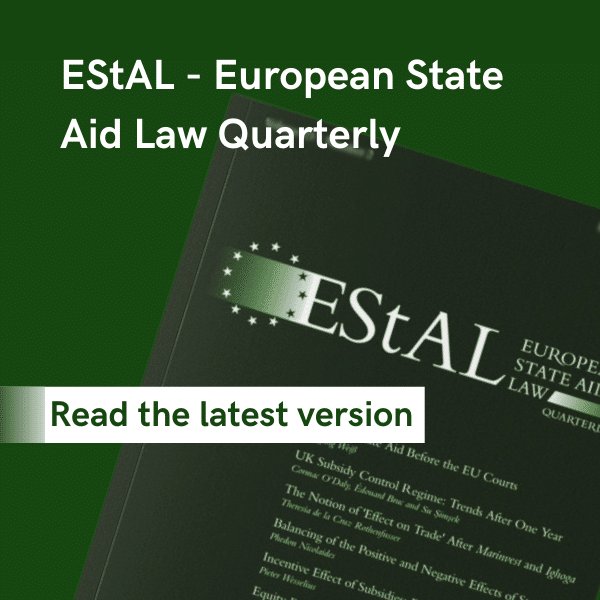
Part II: Advantage
The Commission, first, explained that the “(80) intervention must be considered as a whole, considering the purpose and timing of the various stages in which AMCO’s intervention is to be made, within the context and contents of the second arrangement proposal. Whether or not a transaction is in line with market conditions must be established through a global assessment of the effects of the transaction on the undertaking concerned”.
AMCO’s intervention in the context of a business strategy with Pini Italia
(81) AMCO’s intervention takes place in partnership with Pini Italia. The second arrangement derives from a financial and industrial strategy between both partners. As evidenced by Italy […], their positions are complementary, as AMCO intervenes as a financial partner and Pini Italia provides financing and industrial investments […] The second arrangement has been approved by the competent court, as a result of a strategy involving both partners and providing for simultaneous and coordinated implementation of the investment in Ferrarini.”
“(82) The decision of AMCO’s Board of Directors was based on the rationale of improving the recovery of its claims, […], since with the second arrangement proposal AMCO would recover 30% of its claims compared to 17.5% with the first arrangement proposal. AMCO based its decision process on internal and external audits on Ferrarini and Pini Italia, drafted by independent experts, and on the comparison with the two alternative scenarios of the first arrangement proposal and the liquidation one. The financial benefits of the second arrangement proposal for AMCO were also confirmed by the Judicial Commissioner, who made a comparison with the bankruptcy alternative […] His conclusion was that the bankruptcy alternative would have resulted in a zero recovery for AMCO. Therefore, AMCO acted in the same way as a private operator in the second arrangement proposal in Ferrarini’s pre-bankruptcy proceedings, as its purpose was to reach the maximum percentage of recovery of its claims against Ferrarini.”
“(84) AMCO committed to acquiring a minority stake (20%) in the share capital of RIA, the corporate vehicle set up for the purpose of investing in Ferrarini’s arrangement, while the majority share (80%) will be held by the private industrial partner, Pini Italia. This corporate structure indicates that the terms and conditions of the investment – and therefore the level of risk and remuneration – applicable to AMCO are at a lower or equal level compared to those applicable to Pini Italia, to which effective business responsibility is attributed […] AMCO’s investment was thus made in the light of the expected future returns that a private investor, an industrial partner like Pini Italia, considered to be sufficiently attractive to provide […] the amount of the investment in RIA undertaken by AMCO. Indeed, […], for a shareholding equal to […] of RIA’s capital, Pini Italia invests EUR […] million (up to EUR […] million […]) and around EUR […] million in a new plant. AMCO finances its minority share in RIA ([…]) via the contribution of a claim that nominally amounts to EUR […] million, but whose real value was expected to be close to […] and, due to the agreement reached with Pini Italia, it should bring AMCO not less than EUR […] million […] The credibility of the assumptions on which AMCO’s strategy was based, including the solidity of the partnership with Pini Italia, was assessed by AMCO also through the reports prepared by independent consultants”.
“(85) AMCO, acting in the same way as a private player, also negotiated exit conditions […], which are usual market practice, thereby limiting the investment risk over time. […] That option to exit the shareholding further demonstrates that AMCO’s intervention is driven by its assessment of risks and not by the aim to support Ferrarini irrespective of the returns achieved and thus does not confer any advantage on Ferrarini within the meaning of Article 107(1) TFEU.”
“(86) Compared to the first arrangement proposal, as well as to the liquidation scenario […] the second arrangement proposal of Pini Italia and AMCO is more advantageous not only from the point of view of AMCO (and a hypothetical market operator in a comparable situation), but also for the industrial prospects and future profitability of Ferrarini. The second arrangement proposal ensures direct business continuity with the end of ownership and management by the Ferrarini family: the management will be carried out by a single entity, RIA, jointly controlled by Pini Italia and AMCO, the latter in its capacity as a minority shareholder with veto powers.”
“(90) AMCO’s intervention takes place within the framework of insolvency proceedings – with the substantive and procedural guarantees laid down in the Bankruptcy Law – with the possibility for other entities to submit their own bids. The Pini-AMCO proposal in taking over Ferrarini’s activities has been objectively chosen as the most advantageous one by the competent actors in Ferrarini’s insolvency procedure.”
“(91) Hence, AMCO’s advantage in adhering to the second arrangement proposal is clearly shown by (i) the higher reimbursement rate of its claims against Ferrarini, as compared to any other scenario […], as well as (ii) the value enhancement of its claims against Ferrarini’s shareholders […], obtained by covering the price of the new shares representing 20% of the share capital of Ferrarini’s future sole shareholder (RIA) with AMCO’s claims against those shareholders. There is therefore a clear economic logic to AMCO’s intervention in the second arrangement proposal”.
The financing (EUR 12 million loan) to be granted to Ferrarini by AMCO
“(92) In accordance with the case law of the Union Courts, which the Commission considers relevant also in the context of the Reference Rate Communication, the Commission intends to verify whether the interest rate of the loan granted by AMCO, taken separately from the capital contribution to which it is inextricably linked is at least as high as the corresponding interest rate benchmark that can be found on the financial markets for similar transactions. Should it be the case, the interest rate of the loan would not contain aid.”
“(93) As established by the Court, it is only if there is no market interest rate and if the Member State wishes to use the reference rate as a proxy, that the Commission may use the latter method, based on the ‘reference rate’. The Commission should therefore use the reference rate only if there is no available benchmark on the market.”
“(94) In the case at hand, it is not possible to identify sufficiently similar financing operations on the market. Ferrarini is not a listed company and does not have any recent official rating, which would constitute a valuable criterion for the assessment of a sufficiently similar borrowing transaction on the market. In addition, the financial package provided by the second arrangement proposal is specific in that it includes equity and debt and does not directly correspond to other sufficiently similar market transactions. Specific conditions inherent to the distressed company itself determine the financial conditions of a transaction: its size, the market on which it operates and the financial package negotiated for the restructuration of the company. It is therefore very disputable to compare financial transactions involving different companies acting on different markets, even if located in the same geographical area.”
“(96) The Commission will therefore use the ‘reference rate’ methodology to assess any potential aid in the interest rate of the loan. The Commission provides the following guidance in its Notice on the notion of State aid for verifying the compliance of loan terms with market conditions: ‘For loans, the method for calculating the reference rate, which is used as a proxy for the market price in situations where comparable market transactions are not easy to identify (usually more frequent in the case of small transactions and/or transactions involving small and medium-sized enterprises (SMEs)), is provided for in the Reference Rate Communication’. That Communication provides for the method for calculating the reference rate, which is used as a proxy for the market price in situations where comparable market transactions are not easy to identify. The reference rate is, however, considered only as an indicative value.”
“(97) AMCO’s financing of Ferrarini, […], has the nature of privileged claim and is backed by a package of collaterals.”
“(98) The loan is backed by the guarantees […] They are issued by Ferrarini, its industrial partners, Pini Italia and Pini Holding, and by RIA.
− The first collateral […] represented by the guarantee by the borrowers (Pini Italia and Pini Holding) […] can be assessed through the creditworthiness of the Pini Group, in
particular its asset and financial soundness. […] The Pini Group therefore demonstrates solvency and liquidity to honour with its own revenues and resources the EUR […] million guarantee to AMCO if Ferrarini defaulted in repaying the loan provided by AMCO.
− The value of the mortgage deed on an industrial property for the slaughter and processing of pigmeat (slaughterhouse), owned by Pini Italia, results […] at an estimated value of the underlying asset of EUR […] million.
− The pledge on the trademark ‘Ferrarini’ is assessed in the appraisal report commissioned by the Judicial Commissioner on the First Arrangement: the value of the “Ferrarini” brand is estimated at EUR […] million in the hypothesis of business continuity and EUR […] in the hypothesis of bankruptcy.
− The pledge on the shares representing the entire share capital of Ferrarini is assessed by the value of Ferrarini itself. The Judicial Commissioner prudentially valued the Ferrarini company at EUR […] million”.
“(99) Because the cumulated value of the collaterals exceed by far the amount of loan by AMCO even if the assets pledged as collateral were valued less than estimated and could secure full reimbursement if Ferrarini failed to reimburse the loan, the guarantee package can therefore be considered as satisfactory. In the worst case scenario of Ferrarini’s liquidation, through the collateral granted, AMCO should be in the position to recover its EUR 12 million loan and the cash flows generated by interests and fees estimated at about EUR […] million in […]years […] This quality of collateral justifies the pricing applied to the loan ([…] EURIBOR plus […] basis points).”
“(100) As Ferrarini is in serious financial difficulties, the reference rate for the assessment of compliance with market conditions of AMCO’s financing is that of the lowest rating category of the debtor firm (CCC), which includes undertakings in financial difficulties. Taking into account a high collateralisation level, […], a 400 basis points margin should be applied to Euribor 1 year. AMCO’s financing bears an interest rate of […] Euribor plus a spread of […] basis points […], i.e. a margin significantly higher than the value identified as reference rate by the Commission in this case.”
“(101) In addition, a fee to be paid out in favour of AMCO (arrangement fee) of […]% of the capital […] remunerates the assistance provided under the funding operation. This fee increases the overall remuneration of AMCO, which reinforces the finding that AMCO’s intervention is comparable in all respects to that of a private operator in a similar situation, including remuneration for the activity of financial intermediary for the purposes of organising and structuring the financing operation.”
“(102) In conclusion, AMCO acts in the context of the insolvency procedure of Ferrarini as a ‘[n]ormally prudent and diligent private creditor who is in a situation as close as possible to that of the public creditor and is seeking to obtain payment of the sums owed to it by a debtor experiencing difficulty in making the payments’. AMCO’s behaviour in the present case may validly be ascribed to the aim to maximising the recovery of its claims. In addition, the terms and guarantees of the financing granted by AMCO under the second arrangement proposal – amounting to EUR 12 000 000 – are in line with what the Commission considers to be in line with market conditions for the remuneration of
the loans. On AMCO’s side, the financing of the second arrangement is therefore consistent with the behaviour of a diligent market economy operator.”
Overall conclusion
The complainants also argued that other creditors of Ferrarini benefitted from an indirect advantage. The Commission rejected that argument on the grounds that those creditors only received what the Italian bankruptcy law enabled them to claim.
On the basis of the above findings, the Commission found that AMCO’s intervention did not confer an advantage to Ferrarini and therefore it dismissed the complaint in its entirety.



